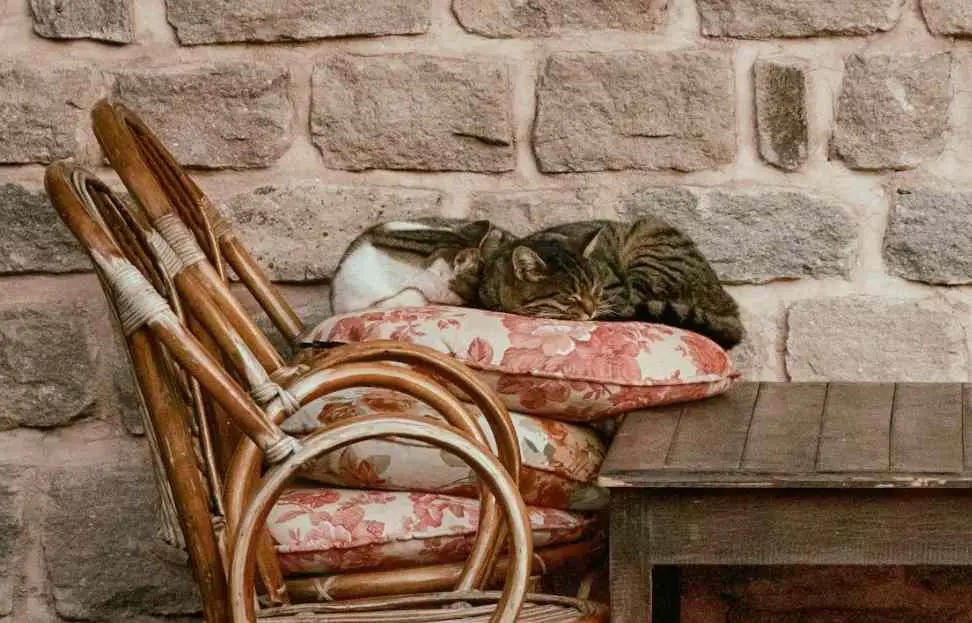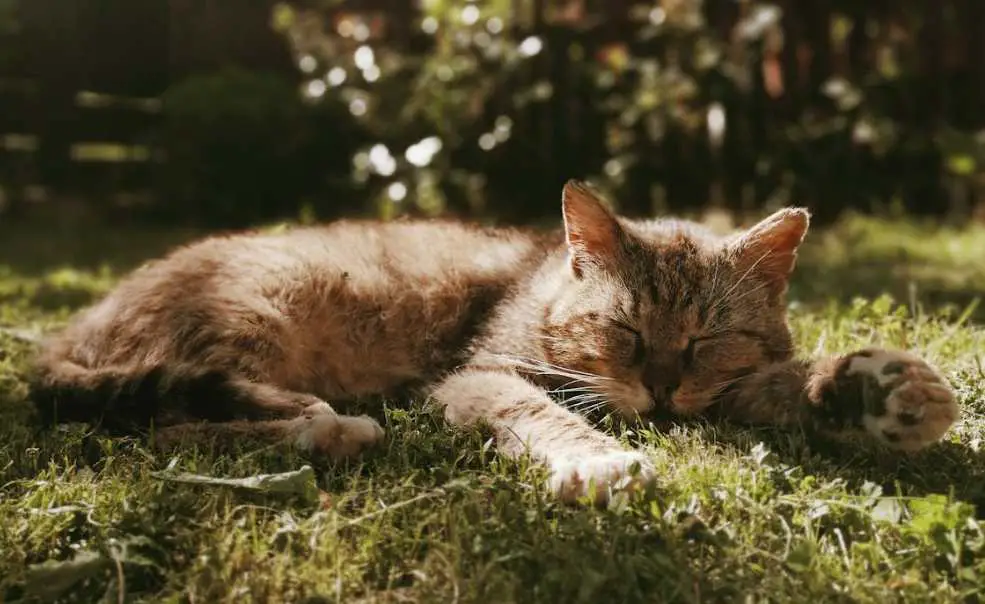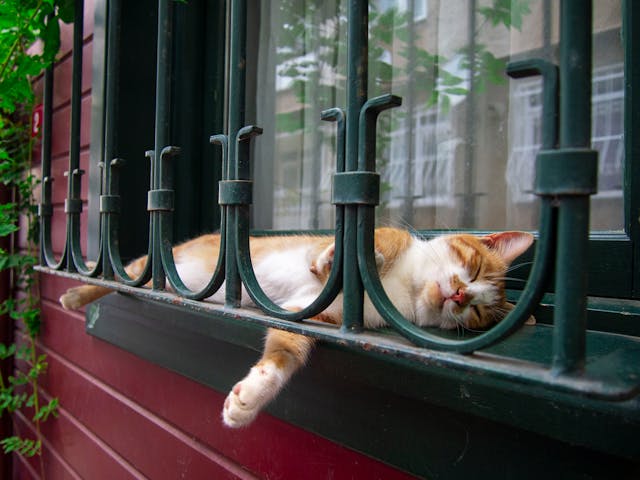Ever wondered where our stray feline friends seek refuge when the moon shines bright? Let’s talk about places stray cats sleep!
Stray cats have mastered the art of finding their ideal sleeping sanctuaries, from hidden nooks of abandoned buildings to cozy corners under porches.
In this blog post, I’ll unveil the mysterious places where cats choose to rest their weary paws.
Let’s get started…
Where Do Stray Cats Sleep
Stray cats typically sleep in hidden spots such as under porches, in abandoned buildings, or thick bushes and shrubbery.
Most stray cats look for places that offer warmth and protection from predators and the elements.
In urban areas, stray cats will also seek refuge in basements, garages, or even inside cars’ engines.
Let’s dive deeper…
Places Stray Cats Sleep
From the information I gathered, here are some of the most common places stray cats sleep:
1. Garages
Based on the information I gathered, garages are often a popular spot for stray cats to find shelter and a place to sleep.
The warmth and protection from the elements make garages an appealing choice for these feline wanderers.
Most cats can easily slip into open garages or find their way through small openings to curl up in a cozy corner.
They might choose to snooze on a pile of old blankets or seek refuge on a dusty shelf.
Garages also provide a sense of security for these cats, offering them a quiet space away from the hustle and bustle of the outside world.
2. Abandoned Buildings

For stray cats looking for safety or where to sleep, abandoned structures are similar to secret shelters.
These stray cats usually feel comfortable and secluded within these decaying buildings, which protect them from the weather and possible dangers.
Stray cats can also take comfort in the crumbling walls, dusty nooks, and dark recesses found within these abandoned buildings.
They could take up residence atop a mound of rubble or improvise a bed from abandoned materials or worn-out blankets.
For these stray cats, abandoned buildings provide a feeling of mystery and intrigue, as well as a makeshift haven.
3. Culverts and Drains
Although they might not seem like the best locations to sleep, sewers and culverts can provide stray cats with a secret haven to sleep.
In addition to offering shelter from inclement weather during the sweltering summer months, these underground passageways are cool and sheltered.
Stray cats will take solace in the seclusion and darkness of these little tunnels as they sleep on a mat of grass or leaves that have made their way within.
These stray cats feel safe and secure in the knowledge that they may sleep in peace, sheltered from the outer world by drains and gutters.
4. Abandoned Vehicles
Abandoned vehicles can become impromptu shelters for stray cats seeking time off or sleeping time.
Old cars left in forgotten parking lots and abandoned trucks hidden in overgrown fields provide stray cats with a comfortable spot to snuggle up and nap.
Stray cats may hide in the car’s dark corners or find warmth in the fabric of the interior.
These abandoned means of transportation give these stray cats a temporary place to live, protecting them from the weather and offering them a spot to rest their tired paws.
5. Woodpiles
Stray cats looking for a warm, safe place to sleep might find a comfortable haven among woodpiles.
Situated away from the weather and any predators, the wood stacks offer a natural hiding place.
Stray cats have the ability to dig deeply into the woodpile’s cracks, making a cozy home for themselves.
For these stray cats, the smell of the wood and its inherent insulation makes it an enticing option.
Woodpiles provide stray cats with a calm area to relax and rejuvenate by creating a feeling of security and coziness.
6. Beneath Decks

Another typical area where stray cats hide out and sleep is beneath decks. The area beneath a deck provides shelter from wind, rain, and very hot or cold weather.
Stray cats can easily squeeze through the deck’s cracks and crevices, making a secret haven for themselves.
They could decide to construct a bed out of twigs and fallen leaves or cuddle up on a soft area of dirt.
Stray cats can find comfort in the isolation and privacy beneath decks, away from humans and other animals’ inquisitive gaze.
7. Attics and Basements
For stray cats in need of sanctuary, attics, and basements are similar to secret hiding places or sleeping areas, stray cats may sleep peacefully and quietly in these isolated spots.
Stray cats can take refuge in dusty nooks, old crates, or on top of insulation in attics.
Contrarily, basements offer a chilly, gloomy atmosphere that is particularly alluring on hot summer days.
Stray cats can seek solace in the dark, hiding behind closet doors or in a peaceful alcove. For these stray cats, attics and basements offer a sense of safety and peace.
8. Alleys and Backyards
Stray cats share sleeping areas in backyards and alleys, these alleys provide a secret haven away from crowded streets in metropolitan settings.
Among the cracks and crevices of buildings, stray cats can take refuge from the bustle and noise of the city.
Stray cats can sleep soundly in their backyards, whether they are in an urban or suburban area.
It’s possible for them to decide to nap on a porch, in garden sheds, or behind shrubs. These stray cats find brief familiarity and a sense of belonging in backyards and alleys.
9. Under Porches
One common area where stray cats go to find safety and a comfortable place to sleep is under porches.
A porch’s underside provides shelter from the weather, including wind, rain, and very high or low temperatures.
Stray cats can simply squeeze between the cracks or crevices and discover a secret haven a short distance from where people normally spend their time.
They could create a bed out of leaves and twigs or snuggle up on a soft area of dirt. Stray cats often feel snug and protected under porches, hidden away from the outside world.
10. Sheds and Barns
For stray cats, sheds and barns serve as makeshift havens where they can sleep in safety.
These structures provide shelter from the weather and any predators, as well as a feeling of security.
Small cracks or holes allow these stray cats to easily enter these structures and take advantage of their warmth and privacy.
They could decide to take a nap in a comfortable nook or lie down on a bale of hay.
These stray cats can find a peaceful and cozy place to rest their tired paws in sheds and barns.
11. Dense Bushes and Shrubs

When stray cats are looking for a safe place to sleep, dense bushes and shrubs provide excellent hideouts.
Because of the protection and camouflage offered by the dense flora, stray cats are able to blend in with their environment.
Nestled among the branches, stray cats may feel safe and protected from inquisitive eyes.
Besides providing shade and protection from the heat and wind, the thick vegetation also creates a cool atmosphere.
For stray cats, natural hiding places like bushes in backyards or plants along lonely paths offer a tranquil haven.
Related: Signs a stray cat likes you.
Where Do Stray Cats Sleep at Night
At night, stray cats often sleep in concealed, sheltered locations like under porches, in abandoned buildings, or in dense vegetation.
They choose these spots for warmth and safety from predators and harsh weather.
In cities, they might also rest in basements, garages, or even the cozy nooks of car engines.
Where Do Stray Cats Stay at Night
Stray cats stay at night in sheltered, hidden places such as under porches, in abandoned buildings, or within thick bushes.
They seek these areas for protection from predators and harsh weather. They might also find refuge in basements, garages, or even inside car engines in urban environments.
Related: Common dangers outdoor cats face.
Where Do Stray Cats Sleep When It’s Cold

When it’s cold, stray cats seek warmth in enclosed, sheltered areas like under porches, inside abandoned buildings, or within dense shrubbery.
They also find refuge in basements, garages, or even inside the hoods of cars. These spots provide necessary insulation and protection from the harsh weather.
Final Thoughts
In summary, understanding where stray cats sleep is crucial for their well-being.
By creating safe havens and cozy shelters, we can make a positive impact on their lives.
Let’s ensure every stray cat has a warm and secure place to rest their paws.
Related: Adopted stray cat behaviors.
Frequently Asked Questions
Let’s take some questions:
Where do stray cats sleep?
Stray cats often seek shelter in various places to sleep, such as abandoned buildings, under porches, in bushes, or in secluded areas like alleys or garages. They may also find warmth and comfort in cozy spots like cardboard boxes or piles of leaves.
Do stray cats sleep during the day or at night?
Stray cats are typically crepuscular, which means they are most active during dawn and dusk. They may sleep during the day, find safe and quiet places to rest, and become more active at night when hunting for food. However, their sleeping patterns can vary depending on their environment and individual habits.
How can I provide a safe sleeping space for stray cats?
If you want to provide a safe sleeping space for stray cats, you can create a shelter using materials like a sturdy box or plastic container with insulation, such as straw or blankets, to keep them warm. Place the shelter in a quiet and protected area, away from harsh weather conditions. Providing food and water nearby can also help attract and provide for stray cats. Remember to approach stray cats with caution and respect their boundaries.
What are some signs that a stray cat is sleeping nearby?
There are a few signs that a stray cat may be sleeping nearby. Look for areas with flattened grass or leaves, as this could indicate a cat has been resting there. You may also notice paw prints or small tracks leading to a hidden spot. Additionally, if you see a cat curled up in a sheltered area or observe a cat entering or exiting a specific location repeatedly, it could be a sign that they have found a sleeping spot.









